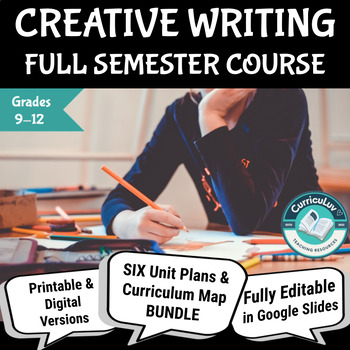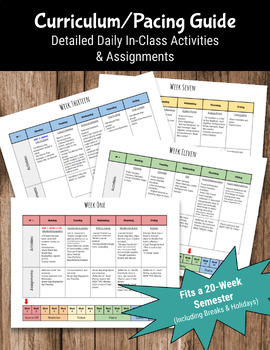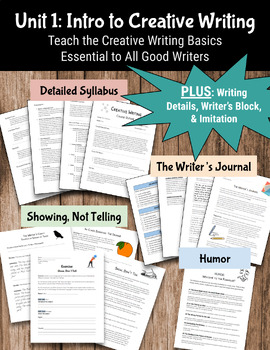High School Creative Writing Complete Semester Course Curriculum BUNDLE
- Zip
Products in this Bundle (48)
showing 1-5 of 48 products
Bonus
Description
This HUGE bundle contains everything a high school creative writing teacher needs to help students embark on an engaging writing journey. All the hard work is done for you to help reduce stress and prep time. Real classroom experience and examples are included based on my many years teaching this creative writing elective to high schoolers in Upstate New York. This resource includes curriculum for a complete semester (20 weeks including breaks & holidays, 16 straight weeks of curriculum).
Dive into SIX UNIT PLANS aligned to the standards, stay organized with a detailed curriculum map and pacing guide, and transition between activities with a thorough Google Slides slideshow for each unit.
WHAT'S INCLUDED:
Editable resources in Google Slides so you can tailor activities to fit your students' needs
- Curriculum Map and Pacing Guide
- Google Slides slideshows for each day's lesson including journal prompts/bell-ringers
- Rubrics for each assignment/assessment
- Detailed teacher directions along with tips and tricks from using these resources in my own classroom
Unit 1: Intro to Creative Writing
- Students learn the creative writing basics essential to all good writers
- Detailed Course Syllabus
- The Writer's Journal
- Showing, Not Telling
- Humor in Writing
- Writing Golden Details
- Writer's Block and How to Get Unstuck
- Imitation
Unit 2: Nonfiction Writing
- Students write thank you letters and personal memoirs
- 6-Word Memoirs
- Writing Dialogue
- Writing Conflict
- How to Be Concise
- Workshop Etiquette
Unit 3: Fiction Writing
- Students dive into the genres of flash fiction and writing a fictitious food review
- Comic Stip Project
- Science Fiction Activity
Unit 4: Poetry Writing
- Students explore 8 different poetic forms: cinquain, list poem, found/redacted poetry, haiku, sonnet, villanelle, limerick, & ode
- Poetry Collection Assignment
- Iambic Pentameter Lesson
- Poem Sampler Activity
- Poetic Elements
- Rubrics, keys, & student examples
Unit 5: Drama & The Ten-Minute Play
- Students engage in collaborative group work with the Ten-Minute Play
- Sample plays
- Play Charades
- Watch a video montage to compare dramatic elements, and more!
Unit 6: The Final Portfolio
- Students create a portfolio of their best work by revising/editing previous work & writing a new piece
- Reflection assignment to reflect on growth and successes throughout the semester
- Rubric, format, and new submission directions included!
*Teacher directions included for all activities
*All resources are editable in Google Slides





